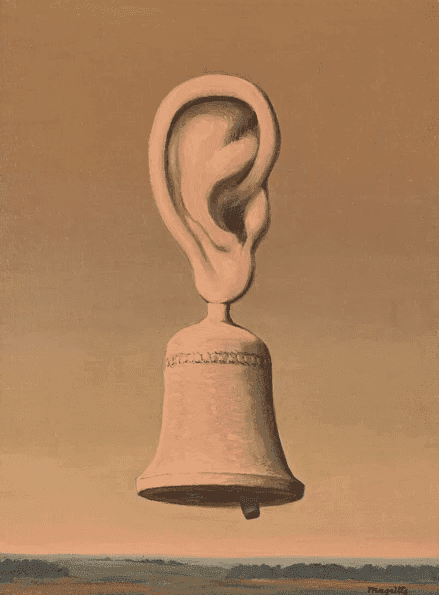How to Mix Traditional and Modern Art in Your Home
Introduction
Art is one of the most powerful tools for personalizing your living space. Whether it’s a centuries-old oil painting or a sleek modern print, each piece tells a story and shapes the mood of your home. But what happens when your taste straddles both ends of the spectrum? Can you mix traditional and modern art in one cohesive interior?
The answer is a resounding yes. In fact, combining traditional and modern art can create a visually rich, culturally layered, and emotionally resonant environment. This blog will guide you through the principles, techniques, and creative ideas to successfully merge these two worlds, no matter your space or style.
Why Combine Traditional and Modern Art?
Blending traditional and modern art brings together the best of both worlds. Traditional art—think oil portraits, religious iconography, and landscape paintings—often carries historical and cultural weight. It adds warmth, elegance, and a sense of depth to a space. Modern art, on the other hand, is bold, abstract, and forward-thinking. It offers energy, contrast, and minimalism.
When you combine them, you invite contrast and conversation into your home. You acknowledge the past while embracing the present. It’s not just a design trend—it’s a reflection of how our identities and tastes evolve.
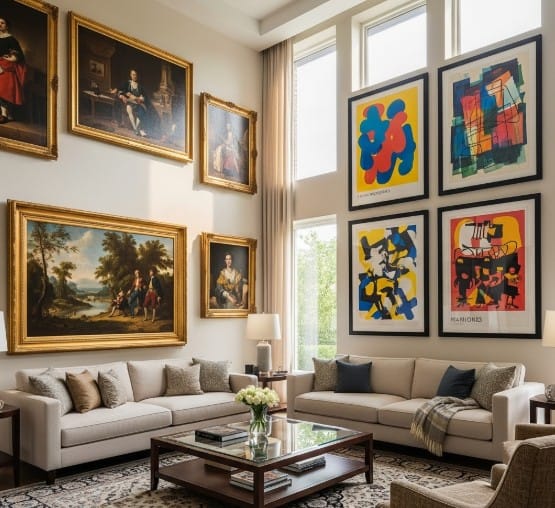
Understand the Core Differences
To mix traditional and modern art effectively, it helps to understand what sets them apart:
- Traditional Art typically includes realistic depictions, religious or mythological themes, rich color palettes, and ornate frames. It’s deeply tied to cultural history and formal techniques.
- Modern Art spans a wide range—from early 20th-century movements like Cubism and Expressionism to contemporary digital art. It emphasizes experimentation, abstraction, and often challenges conventions.
Knowing these distinctions allows you to play with contrast intentionally, rather than accidentally creating a jarring or mismatched look.
Start with a Neutral Base
One of the best ways to allow both styles of art to shine is to begin with a neutral base—walls in whites, greys, or muted earth tones. This backdrop doesn’t compete with the artwork and gives your traditional and modern pieces equal visual footing.
Neutral interiors act like gallery spaces. They let you control the dialogue between styles without overwhelming the room. You can later add color through accessories, rugs, or furnishings to echo themes in your art.
Use a Unifying Color Palette
A cohesive color palette can tie together the most diverse collection. Even if your artworks differ in subject and style, using a common thread—such as dominant hues of blues, golds, or earthy tones—can make the space feel unified.
For example, a gold-framed classical Indian miniature painting can sit beautifully beside a modern canvas with golden brushstrokes. It’s about harmony, not sameness.
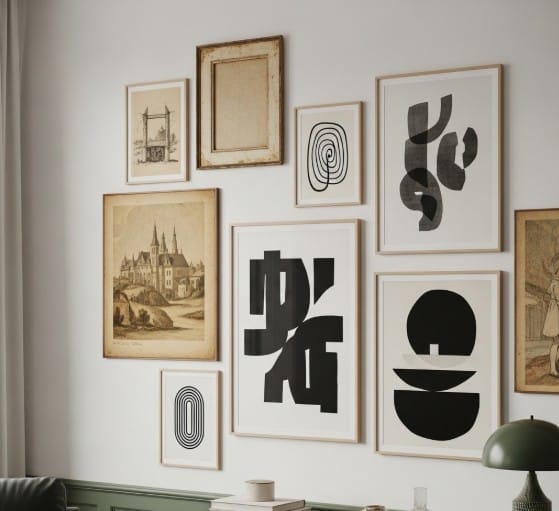
Create Balance Through Placement
How and where you place art makes a huge difference. Don’t cluster all traditional pieces on one wall and all modern works on another. Instead, intersperse them thoughtfully.
Try these strategies:
- Pair opposites: Place a bold abstract painting beside a soft, traditional portrait to create visual tension.
- Layer styles: Lean a modern print against the wall on a console table, and hang a traditional painting just above it.
- Use symmetry: Anchor both sides of a space with different styles of art to create balance.
This approach creates a rhythm in the space, guiding the eye and allowing each piece to contribute to the whole.
Mix Frames Intentionally
Frame choice can either emphasize or neutralize the stylistic divide. Ornate, gilded frames typically belong to traditional works, while modern art tends to be in simple black, white, or floating frames.
But you can mix them:
- Echo formality: Use a modern floating frame for a classical painting to give it a fresh twist.
- Elevate the unexpected: Place an abstract piece in a baroque frame to create surprise and sophistication.
- Unify with material: Use wood or metal frames across all works to maintain cohesion.
Frames are design elements in their own right—don’t overlook their impact on your overall decor.
Choose the Right Scale and Proportion
Mixing traditional and modern art is not just about style—it’s also about size and visual weight. A gallery wall of small classical sketches might feel lost beside a huge, bold abstract canvas. But if you pair them thoughtfully, the contrast becomes dynamic.
When arranging artworks:
- Place large works next to smaller groupings for balance.
- Use vertical stacking (one above the other) for height and interest.
- Ground heavy traditional frames with modern, minimalist pieces nearby.
The goal is to keep the visual flow smooth, allowing the eye to travel without abrupt stops.
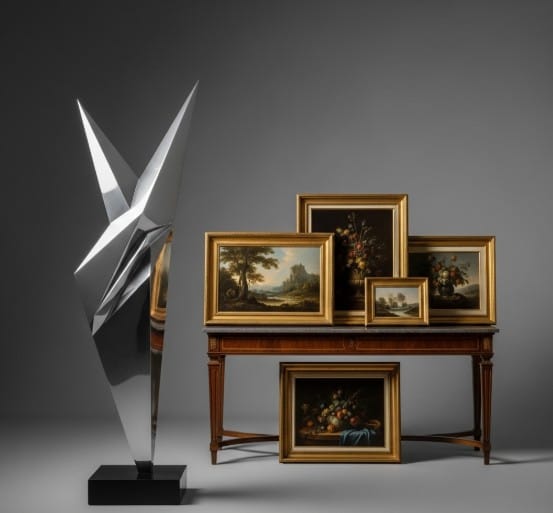
Create Gallery Walls with Intent
Gallery walls are a great way to bring together different styles. They work especially well in hallways, staircases, or above sofas. To mix traditional and modern art in a gallery wall:
- Lay it out on the floor first to experiment with placement.
- Mix frame styles and art periods, but keep spacing consistent.
- Include a variety of mediums: oils, prints, photography, and even textiles.
Add sculptural elements like masks or artifacts to add depth and cultural resonance.
Blend Cultures and Time Periods
Modern doesn’t have to mean Western. There are many contemporary artists creating innovative work rooted in traditional Indian, African, or Indigenous art forms. Likewise, traditional art can be surprisingly modern in composition or theme.
At ISKUSS, for example, we curate artwork that blends heritage with modern sensibility. Our collection features traditional spiritual motifs and abstract contemporary pieces, offering a perfect harmony for culturally aware collectors.
When you blend artworks from different cultures and time periods, you enrich your home with stories, context, and personality.
Let One Piece Lead the Narrative
If you’re unsure where to begin, select one standout piece—traditional or modern—and let it set the tone. Build around it with complementary or contrasting works.
For example, a large spiritual landscape can act as the anchor. You can then layer in modern minimalistic works that echo its color or energy, allowing both pieces to shine without competing.
This focal-point strategy makes it easier to curate intentionally and avoids a cluttered look.
Incorporate Art into Functional Design
Art doesn’t have to be confined to walls. You can integrate both traditional and modern aesthetics into everyday items:
- Use modern light fixtures in a room dominated by classical artworks.
- Pair a contemporary sculpture with a vintage sideboard.
- Choose traditional textiles or rugs that echo the color scheme of modern canvases.
These crossovers keep your space interesting and allow art to flow into the rhythm of daily life.
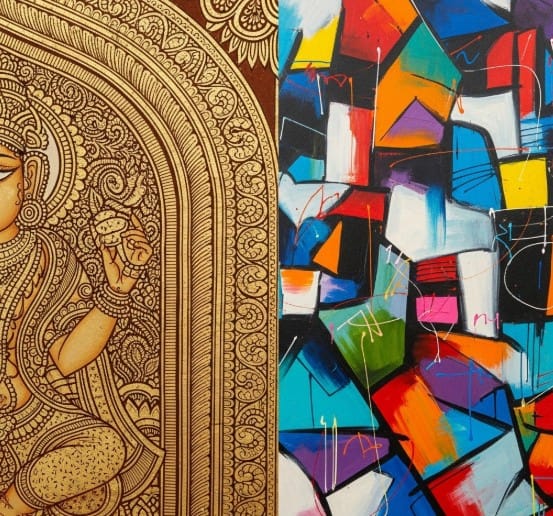
Use Lighting to Enhance the Contrast
Proper lighting can elevate both traditional and modern art. Use directional spotlights for classical paintings to highlight texture and detail. Use diffused, ambient lighting for modern works to emphasize mood and color.
You can also use lighting design itself as a bridge—sleek, minimalist fixtures that highlight ornate traditional works can be striking and elegant.
Consider using picture lights, LED strips, or dimmable sconces to create atmosphere and bring focus to your art collection.
Rotate Art for Fresh Perspectives
Your collection doesn’t have to stay static. Rotating pieces seasonally or periodically can breathe new life into your space. It also allows different combinations of traditional and modern pieces to take center stage.
For example, display bold, abstract art in summer for a fresh vibe, and return to warm, classical pieces in winter for coziness and nostalgia. Rotating art also encourages you to keep engaging with your collection in meaningful ways.
Trust Your Instincts and Tell Your Story
The most important rule in mixing traditional and modern art is to make it your own. Your space should reflect your experiences, tastes, and emotional connections. Don’t be afraid to break conventions or pair unlikely works together.
Art is personal. A minimalist Japanese ink painting and a vibrant Indian folk piece can share a wall if they both resonate with you. If your collection tells your story, the blend will feel intentional and alive.
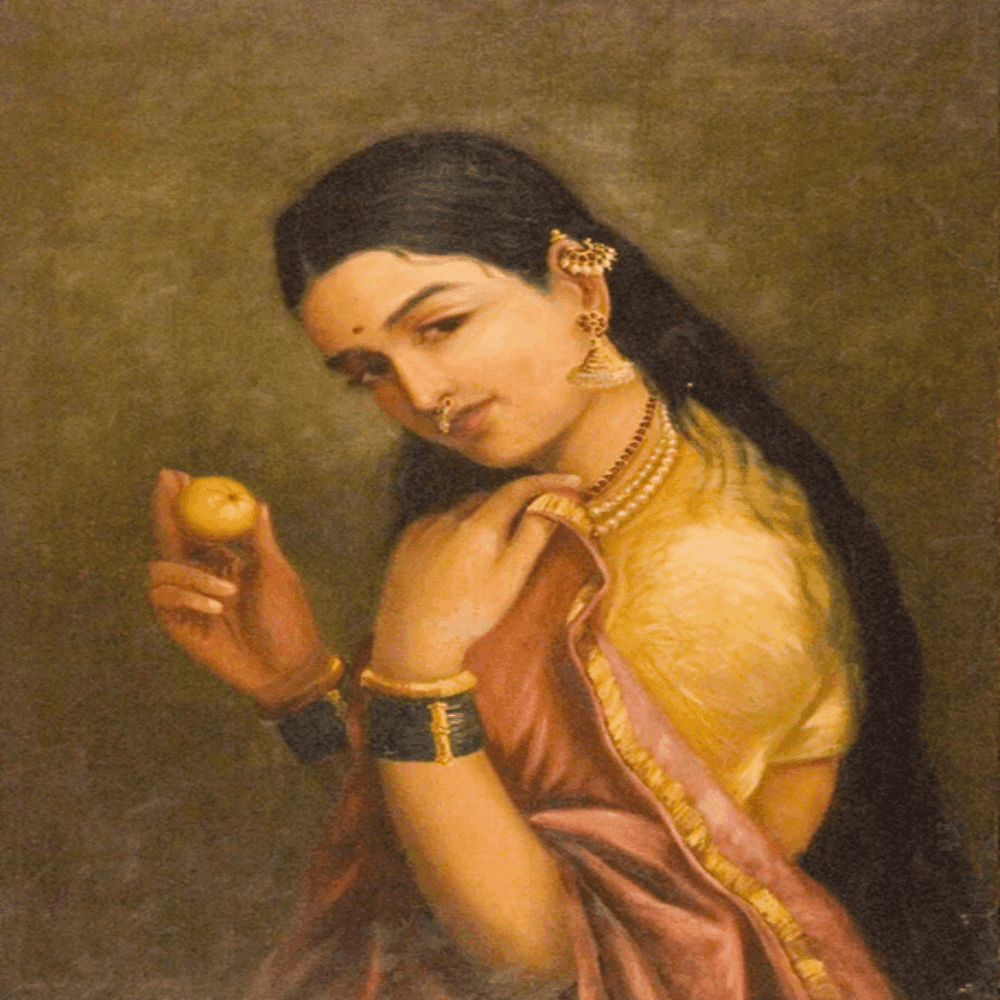
Common Mistakes to Avoid
While mixing styles is creative and flexible, here are a few pitfalls to watch for:
- Overcrowding: Too many pieces in a single area can make even great art feel overwhelming.
- Ignoring scale: Uneven proportions can throw off the visual balance.
- Forcing uniformity: Don’t try to match everything perfectly. Cohesion doesn’t mean sameness.
- Skipping planning: Lay out your ideas beforehand. Use paper cutouts or digital tools to preview arrangements.
A little planning helps maintain harmony while celebrating contrast.
Where to Find Traditional and Modern Art
If you’re building your collection, consider exploring diverse sources:
- Local galleries often showcase both traditional and modern artists.
- Online platforms like Saatchi Art offer curated, international selections.
- Cultural institutions or artist-run markets support emerging talent and provide authentic options.
- ISKUSS, our art platform, offers premium curated pieces that reflect global influence and cultural depth. From spiritual Indian paintings to minimalist contemporary works, visit ISKUSS to find art that merges tradition with modernity.
Conclusion
To mix traditional and modern art in your home is to create a visual dialogue between past and present. It’s an act of storytelling that brings richness, diversity, and depth to your space. By understanding contrast, using unifying design elements, and trusting your intuition, you can curate a home that is both timeless and contemporary.
Whether you’re drawn to the ornate brushwork of traditional paintings or the bold experimentation of modern art, you don’t have to choose one over the other. Celebrate both, and let your home become a living canvas of cultures, styles, and eras.
